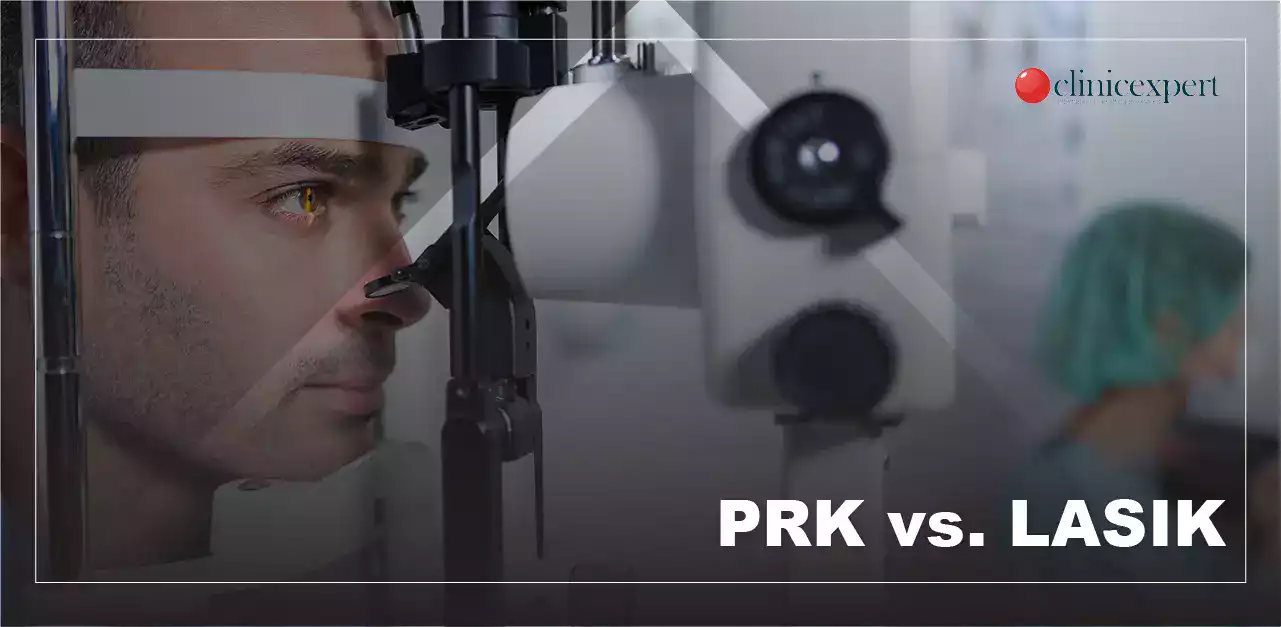LASIK vs. PRK: What is the Difference?
When it comes to improving vision through refractive laser eye surgery, PRK and LASIK are two of the most popular and widely discussed options. PRK stands for Photorefractive Keratectomy, while LASIK is the abbreviation of Laser-Assisted In Situ Keratomileusis. Both procedures aim to correct vision issues like nearsightedness, farsightedness, and astigmatism. They offer a potential and permanent escape from glasses or contact lenses.
However, despite their common goal, PRK and LASIK have distinct differences that might make one more suitable than the other depending on individual circumstances. In order to understand the difference between the two procedures, we first need to talk about how both treatments work.
What is LASIK?
LASIK is a type of refractive eye surgery that reshapes the cornea—the clear front part of the eye—to improve vision. During the procedure, a surgeon uses a laser to create a thin flap in the cornea, then folds it back to reshape the underlying corneal tissue. This reshaping allows light entering the eye to be properly focused onto the retina, resulting in clearer vision. The flap is then laid back in place, where it heals over time without the need for stitches.
What is PRK?
PRK is another form of refractive surgery that also reshapes the cornea to correct vision. Unlike LASIK, PRK does not involve creating a corneal flap. Instead, the outer layer of the cornea (the epithelium) is gently removed, and a laser is used to reshape the underlying corneal tissue. The epithelium naturally regenerates over the next few days following surgery. Because there’s no flap creation, PRK is often recommended for individuals with thin corneas or other corneal issues.
What are the Key Differences between PRK and LASIK?
- Procedure Technique: The fundamental difference lies in the approach to accessing the corneal tissue. LASIK involves creating a flap, while PRK removes the outer corneal layer altogether.
- Recovery Time: Recovery from PRK is generally slower than LASIK. PRK patients often experience more discomfort and a longer healing process, typically several days to a week, as the outer layer of the cornea needs time to regenerate. LASIK patients usually recover faster, with many experiencing significant vision improvement within 24 hours.
- Suitability: PRK is often recommended for patients with thin corneas, those at higher risk of eye injuries (e.g., athletes), or individuals with certain corneal conditions. LASIK is suitable for a broader range of patients but might not be the best option for those with very thin corneas or other specific eye characteristics.
- Risk of Complications: Both procedures carry a risk of complications, but the nature of these risks can differ. For instance, because LASIK involves creating a corneal flap, there’s a small risk of flap-related complications. PRK eliminates this risk since no flap is created, but it can have a higher risk of post-operative discomfort and longer visual recovery time.
The Pros and Cons of PRK vs. LASIK
When deciding between PRK and LASIK, it’s essential to weigh the pros and cons of each procedure.
Pros of LASIK
- Quicker visual recovery
- Less discomfort in the days following surgery
- More immediate results
Cons of LASIK
- Potential for flap-related complications
- Not suitable for everyone, particularly those with thin corneas
Pros of PRK
- No risk of flap complications
- Suitable for patients with thin corneas or those disqualified from LASIK
- Beneficial for individuals with active lifestyles or jobs that pose a higher risk of eye injury
Cons of PRK
- Longer recovery time
- More discomfort during the initial healing phase
- Slower improvement in vision
Making the Right Choice
Choosing between PRK and LASIK is a personal decision that should be made based on a thorough understanding of each procedure, a detailed eye examination, and a discussion with a qualified eye surgeon. Factors such as your eye health, lifestyle, and vision goals play a crucial role in determining the most suitable option.
If you’re considering refractive surgery, start by scheduling a consultation with an eye care professional who can evaluate your eyes and provide personalized advice. Remember, both PRK and LASIK have transformed the lives of millions around the world, offering a glimpse of a life less dependent on corrective eyewear. With the right guidance and information, you can make a choice that aligns with your vision needs and lifestyle preferences.
Contact Us
The journey to clear vision is a personal and impactful decision. PRK and LASIK each offer unique advantages and considerations. By understanding the differences between these two pioneering vision correction procedures, you’re better equipped to discuss options with your eye care provider and make an informed choice that best suits your needs. Remember, the goal is not just to see better but to enhance your quality of life through improved vision. Whether you choose PRK or LASIK, you’re taking a step toward clearer, more vibrant visual experiences.
If you would like to benefit from a free consultation about eye treatments, you can fill out the form on the side, or contact us via WhatApp or our phone line.

